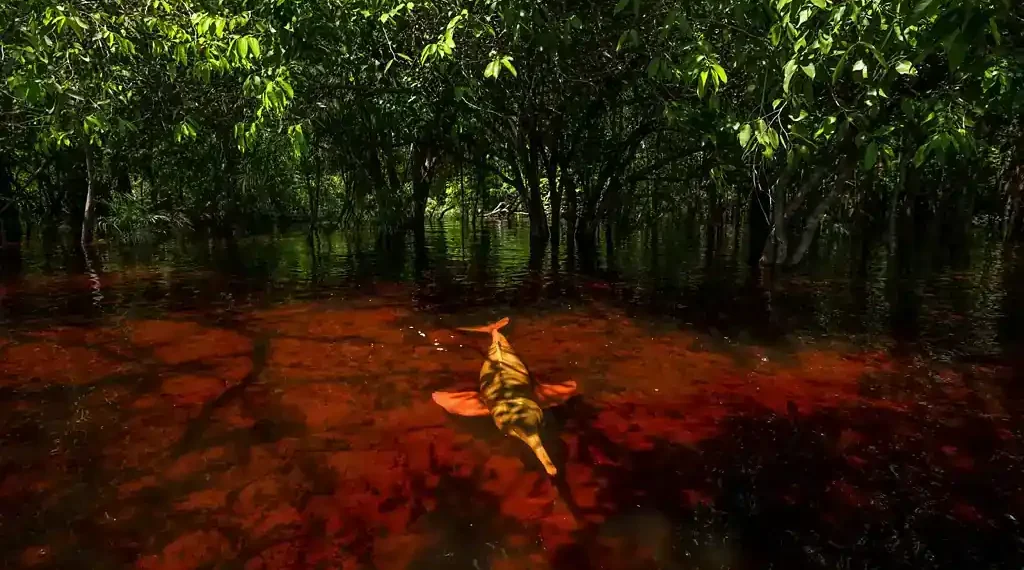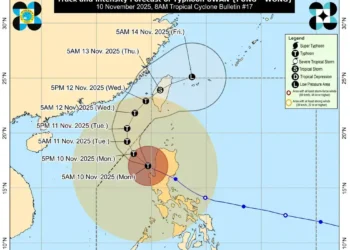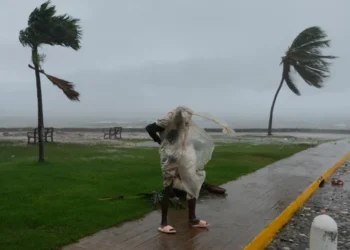The Story Behind the Pink Dolphins’ Battle for Survival in the Amazon
In the fading light of a 2023 sunset, photographer Thomas Peschak slipped into the dark waters of Brazil’s Rio Negro River, his camera ready. Moments later, a flash of pink broke the surface — an Amazonian pink river dolphin darted toward a fishing net, punctured it with its long snout, and made off with a catfish. Peschak captured the entire act underwater, a moment he describes as both exhilarating and rare.
“They are very agile and can manoeuvre with incredible exquisiteness around these nets underwater,” he said. “They are great thieves!”
The striking images, the first ever to document this behaviour underwater, earned Peschak the Photojournalist Story Award at the 2024 Wildlife Photographer of the Year competition. But behind the playful theft lies a deeper story — one of survival, folklore, and urgent conservation across the Amazon Basin.
The Elusive ‘Boto’: The World’s Largest Freshwater Dolphin
Known locally as boto in Portuguese and bufeo in Spanish, the Amazon pink river dolphin is one of the region’s most iconic creatures. With a rounded forehead, elongated snout, and skin that blushes from grey to pink as they age, these dolphins can grow up to 2.5 meters (8.2 feet) and weigh 200 kilograms (440 pounds) — making them the largest freshwater dolphins in the world.
Four types of pink river dolphins inhabit the Amazon and Orinoco river basins, all classified as endangered due to population declines caused by pollution, habitat loss, illegal hunting, and fishing net entanglement.
Their survival depends heavily on the health of the river ecosystem. Using echolocation, they navigate through murky waters by emitting high-frequency clicks and interpreting returning echoes. The rounded “melon” atop their heads amplifies these sounds, allowing them to build a mental map of their surroundings — an essential adaptation for life in near-dark waters.
Folklore, Fear, and the Dolphins’ Double Life
Beyond biology, the pink dolphin holds a mythical place in Amazonian culture. Indigenous stories tell of the boto’s secret life as a shape-shifter — a handsome man who emerges from the water at night to seduce young women before returning to the river at dawn. Other legends describe the dolphins as guardians of underwater cities.
Yet not all tales are kind. Their habit of raiding fishermen’s nets has earned them the nickname “the great thieves,” and in some regions, resentment runs deep. “There are communities where fishermen will actually kill these dolphins out of revenge,” Peschak said during his two-year National Geographic expedition across the Amazon Basin.
A River in Crisis: Nets, Pollution, and Declining Populations
While their cunning may help them steal fish, it offers little protection against modern threats. Marine biologist Fernando Trujillo, a leading expert who joined Peschak’s expedition, has spent over three decades studying the species.
“The nets are our main concern,” Trujillo said. “Every year, in a small area in Colombia alone, more than 700 dolphins die because of fishing nets.”
Trujillo is the founder of the Omacha Foundation, a Colombian non-profit working to protect the Amazon Basin’s aquatic species. The group collaborates with international organizations through the South American River Dolphin Initiative (SARDI), surveying more than 144,000 kilometers (90,000 miles) of rivers across seven countries since 2017.
Health assessments conducted by Trujillo’s team have revealed alarming findings. Many dolphins show contamination from mercury — a byproduct of illegal gold mining — as well as microplastics and signs of respiratory illness linked to forest fires in Brazil’s Amazon region.
“The dolphins are the sentinels of the rivers,” Trujillo said. “If they are sick, it means the river is sick — and that affects people, too.”
Adapting Tradition: Local Communities Join the Effort
To reverse the trend, conservationists are turning to the people who share the dolphins’ habitat. Trujillo’s foundation works with local fishermen, teaching them to safely release dolphins caught in nets and to assist in rescue operations during extreme droughts.
In Brazil, biologist Mariana Paschoalini Frias of the World Wide Fund for Nature (WWF) is leading trials of “pingers” — small devices that emit underwater sounds to deter dolphins from approaching fishing nets.
“Oftentimes, the fish are the only food these families have,” Frias said. “We are trying to find solutions that protect both the fishermen’s livelihoods and the dolphins.”
In the Tapajós River, a tributary of the Amazon, the devices have reduced net damage by around 40%, improving both catches and community income. “Before the project, we didn’t consider the dolphins our friends,” said Elias Correia da Silva, a 52-year-old fisherman. “But today, we do our best to coexist — they have their food, and we have ours.”
Cultural Custodians of the River
Among Indigenous communities, a new generation of conservationists is bridging ancient beliefs and modern science. Romani Peña Gómez, a member of Colombia’s Tikuna people, grew up hearing stories about the boto. Now trained by the Omacha Foundation, he works as both a dolphin health surveyor and ecotourism guide.
“For us, the dolphins are the joy of the river,” Gómez said. “Protecting them means taking care of our own environment. They are the protectors of the rivers.”
His work also supports sustainable tourism, offering an alternative to fishing-based livelihoods while ensuring visitors learn about the dolphins’ cultural and ecological importance.
Climate Change Adds New Risks
The Amazon’s pink dolphins face mounting threats from climate change. In 2023, an extreme drought in Brazil killed more than 130 dolphins after waters became dangerously shallow and exceeded 40°C (104°F).
These deaths underscored the growing urgency to strengthen conservation measures and reduce human-driven stress on the ecosystem. “We can only build a sustainable future for the Amazon if we have its inhabitants leading the way,” said Frias.
A Photographer’s Mission to Inspire Awareness
For Peschak, his photographs are more than stunning visuals — they are a plea for global awareness. “The pink river dolphins represent the most diverse freshwater system on our planet,” he said. “They are a powerful storytelling tool to remind us how fragile and magnificent the Amazon’s biodiversity truly is.”
His work now stands as both artistic achievement and environmental testimony — revealing how a mischievous “thief” can also be a guardian of one of Earth’s most vital ecosystems.
This article was rewritten by JournosNews.com based on verified reporting from trusted sources. The content has been independently reviewed, fact-checked, and edited for accuracy, tone, and global readability in accordance with Google News standards.
Stay informed with JournosNews.com — your trusted source for verified global reporting and in-depth analysis. Follow us on Google News, BlueSky, and X for real-time updates.
JournosNews.com follows Google News content standards with original reporting, verified sources, and global accessibility. Articles are fact-checked and edited for accuracy and neutrality.










